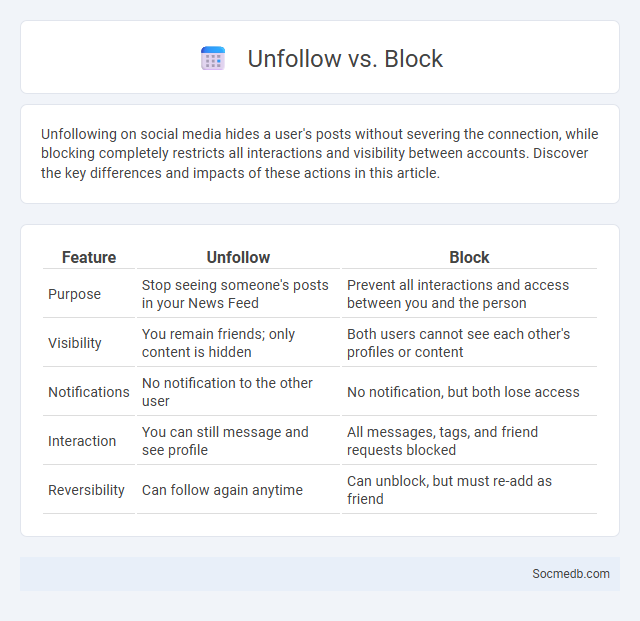
Photo illustration: Unfollow vs Block
Unfollowing on social media hides a user's posts without severing the connection, while blocking completely restricts all interactions and visibility between accounts. Discover the key differences and impacts of these actions in this article.
Table of Comparison
| Feature | Unfollow | Block |
|---|---|---|
| Purpose | Stop seeing someone's posts in your News Feed | Prevent all interactions and access between you and the person |
| Visibility | You remain friends; only content is hidden | Both users cannot see each other's profiles or content |
| Notifications | No notification to the other user | No notification, but both lose access |
| Interaction | You can still message and see profile | All messages, tags, and friend requests blocked |
| Reversibility | Can follow again anytime | Can unblock, but must re-add as friend |
Understanding Unfollow, Block, and Unfriending
Understanding the differences between unfollowing, blocking, and unfriending on social media platforms is essential for managing your online interactions and privacy. Unfollowing allows you to stop seeing someone's posts without severing the connection, while unfriending removes the person from your friends list, cutting off mutual content sharing. Blocking goes a step further by preventing any interaction or visibility between you and the blocked user, ensuring maximum privacy and control over your social media experience.
Key Differences Between Unfollow, Block, and Unfriend
Unfollow removes a user's posts from Your feed without severing the connection, allowing discreet content control. Block completely restricts all interactions and visibility between both parties, ensuring total privacy and safety. Unfriend deletes the connection entirely, removing mutual access to profiles and limiting communication to non-friends only.
When to Use Unfollow: Best Practices
Unfollowing on social media is best practiced when accounts no longer align with your interests, values, or content preferences, reducing feed clutter and enhancing user experience. Regularly auditing your follow list helps maintain relevant and engaging content, improving mental well-being by minimizing exposure to negativity or misinformation. Use the unfollow feature strategically to foster a more personalized and meaningful social media environment.
The Impact of Blocking on Social Connections
Blocking on social media can significantly alter your social connections by limiting access to shared content and communication pathways, often leading to reduced interaction and potential misunderstandings. This action may create social rifts by isolating individuals from mutual friends and disrupting the flow of information within online communities. Understanding the nuances of blocking helps you navigate digital relationships more thoughtfully, balancing privacy with social engagement.
Unfriending: What Really Happens?
Unfriending on social media often signals a shift in personal relationships that can impact online social dynamics and individual digital well-being. This action typically reduces one's social network visibility, affecting content engagement and the flow of information between users. Studies reveal that unfriending can lead to feelings of exclusion, but also serves as a boundary-setting tool essential for managing online interactions and mental health.
Privacy Implications of Each Action
Social media platforms collect vast amounts of personal data through user actions such as posting, liking, and sharing, exposing individuals to privacy risks. Each interaction can reveal sensitive information that may be used for targeted advertising, data profiling, or unauthorized access. Users must understand the privacy settings and data policies of platforms like Facebook, Instagram, and Twitter to mitigate potential breaches and protect their digital identities.
Emotional and Social Consequences
Social media platforms can significantly impact emotional well-being by increasing feelings of anxiety, depression, and loneliness due to constant exposure to idealized images and social comparison. The addictive nature of these platforms often leads to reduced face-to-face interactions, weakening real-life relationships and social skills. Excessive social media use correlates with heightened stress levels and diminished self-esteem, highlighting the need for mindful engagement and balanced digital habits.
Platform-Specific Features and Limitations
Social media platforms each offer unique features tailored to their audience, such as Instagram's visual-centric Stories and Reels designed for short, engaging content, or Twitter's real-time microblogging with character limits fostering concise updates. Limitations like TikTok's focus on vertical videos and algorithm-driven content discovery prioritize trend participation but may restrict long-form storytelling. Understanding these platform-specific capabilities and constraints is crucial for optimizing content strategy and maximizing user engagement.
Managing Your Digital Relationships
Managing your digital relationships requires active engagement, thoughtful communication, and setting clear boundaries to maintain a healthy online presence. Utilizing privacy settings on platforms like Facebook, Instagram, and LinkedIn helps protect personal information and control who can interact with your posts. Regularly reviewing your friend lists, blocking or muting toxic users, and fostering positive interactions contribute to a respectful and supportive social media environment.
Choosing the Right Option for Your Needs
Selecting the ideal social media platform depends on your target audience, content type, and engagement goals. Visual brands often thrive on Instagram and Pinterest, while B2B companies benefit from LinkedIn's professional network. Understanding platform demographics and features ensures optimized reach and meaningful interaction tailored to your specific needs.
 socmedb.com
socmedb.com